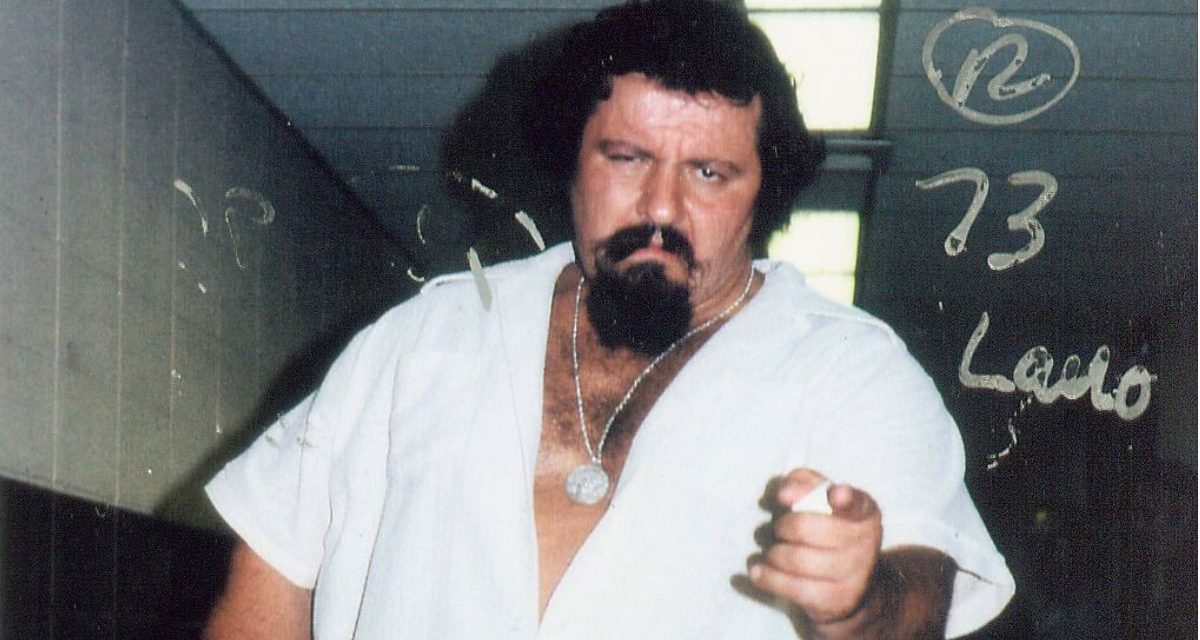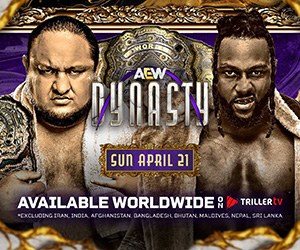O Captain my Captain! Our fearful trip is done,
The ship has weathered every rack, the prize we sought is won
The above lines are from a poem written by Walt Whitman in 1865. But they may mean even more to professional wrestling in 2009.
The wrestling world was saddened by the passing of one of the most beloved and entertaining personalities the business has ever seen. Captain Lou Albano died this morning, October 14, 2009, at the age of 76.
Although he was born Louis Vincent Albano in 1933, he will always be remembered by friends, family members, colleagues and fans as Captain Lou.
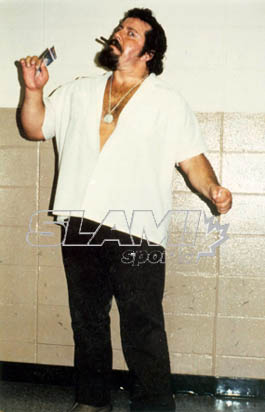
Captain Lou Albano at his peak as a manager, backstage at Madison Square Garden, in the 1970s. Photo by Mike Lano, WReaLano@aol.com
Even in passing, Albano’s memory still lives and breathes and his voice still echoes in the backs of everybody’s mind that he’s had the pleasure of entertaining during his 42-year career.
Over the course of that career, Albano has managed 34 men to championship gold (15 teams and four individuals), which is an accomplishment that few others can claim, and it may even put him in a class all by himself.
Albano is originally from Mount Vernon, NY, but after high school, he attended the University of Tennessee on a football scholarship. Soon after, he left school to join the Army. Albano started taking an interest in professional wrestling while on tour with the Army. At the time, he was working at a bar, as a bouncer, where he met two wrestlers, which influenced him to take wrestling seriously as a career.
He had his first official match in 1953, in Montreal, Quebec, where he defeated Bob Lazaro.
Perhaps Albano’s most successful run as a wrestler was when he was a member of a team known as The Sicilians with Tony Altamore. They had an Italian mobster gimmick and Albano has very fond memories of all the good times spent with his friend Tony and wouldn’t trade it for anything.
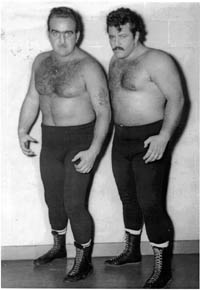
The Sicilians — Tony Altamore and Lou Albano.
“We were a young team years ago in the early ’50s,” Albano said in an earlier interview. “We got together, and I tell you, Tony was a great guy. As a wrestler, I’d put him over myself. Maybe I was a great talker, but Tony was the brains of the outfit.”
The words are repeated time and time again that a gimmick will never get over on its own. It’s the wrestler’s responsibility to get a gimmick over and this particular gimmick did get over and it got over to the point that Albano and Altamore continually had to look over their shoulders, out of paranoia, fearing that they may have upset the Mafia.
“[The Mafia] never actually came to us, but we just, by word of mouth, started hearing that it’s a bad sign to put on the black, velvet glove,” Albano said. “In Mafia, you put your hand up, and after a while, it got to be, ‘What are you doing? Are you nuts?’ So we took the gloves off, and no more Mafia — we didn’t want to have any trouble.”
The Sicilians went on to win the Midwest Tag Team titles and later, would win the WWWF United States Tag Team titles from Arnold Skaaland and Spiros Arion in 1967.
Perhaps Albano’s biggest claim to fame though was his run as a manager in the WWWF (now WWE). He made the transition from wrestling to announcing with some encouragement from Bruno Sammartino, who was the WWWF champion at the time. In fact, Albano’s first task as a manager was guiding the career of the hated Russian Ivan Koloff, in a program against Sammartino, which certainly put a lot of pressure on Albano, since he was involved in the company’s top feud. But Albano was able to overcome that pressure and the company must have felt comfortable enough to give the Albano/Koloff team the ball and let them run with it, because in 1971, Koloff, under the tutelage of Albano, defeated Sammartino to become the new WWWF champion, making him the first of four singles wrestlers that Albano managed to championship gold, ending Sammartino’s seven-year reign.
“Bruno was a great, great champion and a great athlete — they had some great battles back and forth. But I’ve got to give credit; he’s one of the greatest of all time. He was really a 13-year world champion,” Albano said in an earlier interview. “Dead silence came down. They (fans) couldn’t believe it.”
Koloff was possibly more shocked about the title change than his manager, but agrees with Captain Lou that nobody believed it any less than the fans.
“Bruno Sammartino was a legend, and it was very surprising,” Koloff said. “They (fans) didn’t figure that Bruno [would lose]. They definitely were amazed at what happened.”
This was a very special moment in the managerial career of Albano, because it would be the only time he’d ever manage the heavyweight champion of the world. Once Sammartino recaptured his belt from Koloff, nobody from Albano’s stable of talent was able to redeem that loss and get the belt back.
Albano would later manage a series of Intercontinental champions, including the very first Intercontinental Champion Pat Patterson.
“He (Patterson) was out there, as an individual that presented himself. He was a top guy, but he didn’t have the actual ruggedness of the Samoans, Afa and Sika, but he had his way,” Albano said. “He got himself over well.”
Another man that Albano managed to the Intercontinental title was Don Muraco. Muraco was a star on the rise at the time and he knew how to talk and get the crowd riled up. Not to mention his tremendous physique and in-ring skills, so he already had a few things going for him. But perhaps the one thing that allowed him to transition from great to magnificent was his “magnificent” manager.
“He (Muraco) did his job well, got out there, and also verbally, he could get out there and express himself,” Albano said. “He did a lot of takes himself, where he didn’t have to count on just the manager. People accepted him as a villain and that was it. If you saw a guy that was forward, and he was right out there speaking, and he had the ability to get ahead and express himself, then you stay back a little bit as a manager and let him do the talking.”
Other than maybe the Hell in a Cell match between The Undertaker and Mankind in 1998, the most talked about cage match in history is from 1983, featuring The Magnificent Muraco defending his Intercontinental title against Jimmy “Superfly” Snuka. And probably the most replayed footage in WWE history is the ending of that cage match, when Snuka leapt off the top of the cage onto Muraco and the fans went crazy. The significance is that both men, at one time or another, were managed by Captain Lou Albano.
Snuka was actually one of Albano’s earliest protégés. Albano was inducted into the Pro Wrestling Hall of Fame earlier this year, but was unable to attend due to problems with his health. But Snuka remembers his time with Captain Lou quite vividly. He mentioned that Albano and Tony Altamore kind of took him under their wing and whenever the three of them went out to eat, the Sicilians always picked up the cheque, but Snuka then joked about how they later presented him with the receipts.
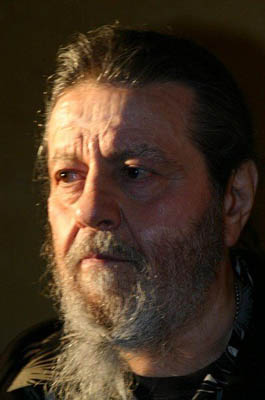
A portrait by Christine Coons.
“He was great. He was an awesome man. Both of us were the bad guys at the time. I loved it,” Snuka said. “They called him names you wouldn’t believe. The heat was fantastic.”
In the ‘70s and ‘80s, a competition was brewing between the managers of the WWWF and maybe rightfully so. When a wrestling company has managers the calibre of Lou Albano, Freddie Blassie and The Grand Wizard, it’s hard to choose any of the three and say “this guy’s the best,” because they were all good at what they did.
“We (managers) wanted to be heard, and having expressed ourselves well, sometimes you would overshadow the other managers,” Albano said. “You would go back and forth, and have your ups and downs. Basically, we always got along.”
Albano had already made a name for himself as a manager, once the ‘80s came around. And most new fans might remember his greatest amount of success, managing tag teams. After all, he did manage fifteen teams to the Tag Team Championships. And each one was seemingly different from the rest, which always allowed Albano to keep things fresh and change up his routine to make himself stand out a little more as well.
Mr. Fuji and Mr. Saito were one of Albano’s first teams to work with and it was a pleasure as always. In fact, Fuji would later follow in Captain Lou’s footsteps as a manager himself.
“Fuji is one of the top guys still around,” Albano said in an earlier interview.
Since then, Albano has managed a plethora of teams such as The Blackjacks, The Moondogs, The U.S. Express and The Executioners. He would speak on their behalf and they would put his words into action.
At Wrestlemania 2, Albano managed a team that is to this day, recognized as one of the greatest tag teams in WWE history, the British Bulldogs (The Dynamite Kid and Davey Boy Smith). The Bulldogs won the titles on that night and became one of the final two teams that Albano would manage to championship gold.
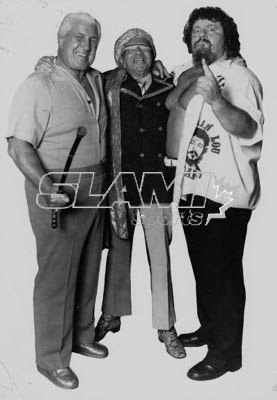
Freddie Blassie, The Grand Wizard and Captain Lou Albano.
“Very, very athletic type team,” Albano said about the Bulldogs. “They tried to keep to themselves and do the right things but sometimes it doesn’t work out right.”
What Albano was referring to is the way they conducted themselves outside the ring and how they would sometimes get into trouble, which could have been avoided. Nevertheless, they were a tremendous team and under the guidance of Albano, they were able to achieve levels of success that they had never seen before and it made them hungry for more.
One of the differences between a good manager and a great manager is that a great manager will go through great lengths to get his/her clients over. Albano was faced with many challenges during his career as a manager, but was able to overcome them. Possibly one of the biggest challenges for Albano was being paired with foreigners or guys who, due to gimmick restrictions, were unable to talk.
It was a true test for Albano, but he was able to break any language barrier put in front of him and convince people that his clients were actually worth millions of dollars. Even in his last run with WWE in 1994, Albano proved yet again that he still had it, when he co-managed The Headshrinkers, who also won championship gold.
This wasn’t the first time Albano managed a team of Samoans. In fact, Samoans and wrestling go together like shoes and socks. But Albano previously managed two of the Headshrinkers’ relatives, Afa and Sika, otherwise known as The Wild Samoans.
“First of all, they were huge sized guys — not in height, they were maybe 6’1″, 6’2″ — they weighed 300 pounds. They were vicious type people. When I say vicious, I don’t mean in personality, I mean inside of the ring,” Albano said. “They really loved to get in there and battle. They’d whack each other. In fact, as brothers sometimes, they’d get in the ring and just start arguing and have a battle.”
Another international star that Albano managed was a man from New Zealand, named Tony Garea, who was a member of the WWE’s family for years, even after his retirement. “Tony Garea was very, very quick in his thoughts and his actions. He was a very knowledgeable wrestler,” Albano said.
In the 1980s, the WWE was making some significant changes and the business evolved from pro wrestling into sports entertainment. Albano was an instrumental part of making some of those changes possible. One of them was incorporating celebrities into some of the top angles, in an attempt to secure a place for pro wrestling within pop culture. It was a huge risk at the time, but a risk that would eventually pay off and also prove that if done right, celebrity angles can be very effective.
Albano’s involvement in this process increased the WWE’s popularity tremendously. He started appearing in some of Cyndi Lauper’s music videos, such as “Time After Time,” “She Bop,” “Girls Just Want To Have Fun,” and “The Goonies ‘R’ Good Enough.” This publicity gave Vince McMahon the idea to create the Rock ‘N’ Wrestling storyline. Albano made a public appearance at Madison Square Garden, before the first Wrestlemania, where he made a few sexist comments that offended both Cyndi Lauper and non-wrestling fans. He also started making outrageous claims that he was Lauper’s manager and single-handedly responsible for the success of her career.
This led to a physical confrontation between the two at an event, co-promoted by the WWE and MTV, called “The War to Settle the Score.” Albano lost and shortly thereafter, publicly apologized to Lauper and then went from a heel to a babyface instantly.
Superstar Billy Graham mentioned in his book Tangled Ropes, that Albano always made the best of every situation. Graham remembers one incident in particular that separates Albano from all the rest.
“Instead of juicing the regular way, Albano carried around a straight razor. He told me that he once slipped doing a blade job and ripped open his cheek,” Graham said. “As a result, he began piercing his cheeks and hanging rubber bands from the loops.”
Working with Lauper, Albano realized that his talent really had no boundaries and he would leave the WWE in 1986 to try his luck in Hollywood. He made appearances in various TV and movie projects such as Hulk Hogan’s Rock ‘N’ Wrestling, 227, Miami Vice, Hey Dude, and the 1987 wrestling movie Body Slam.
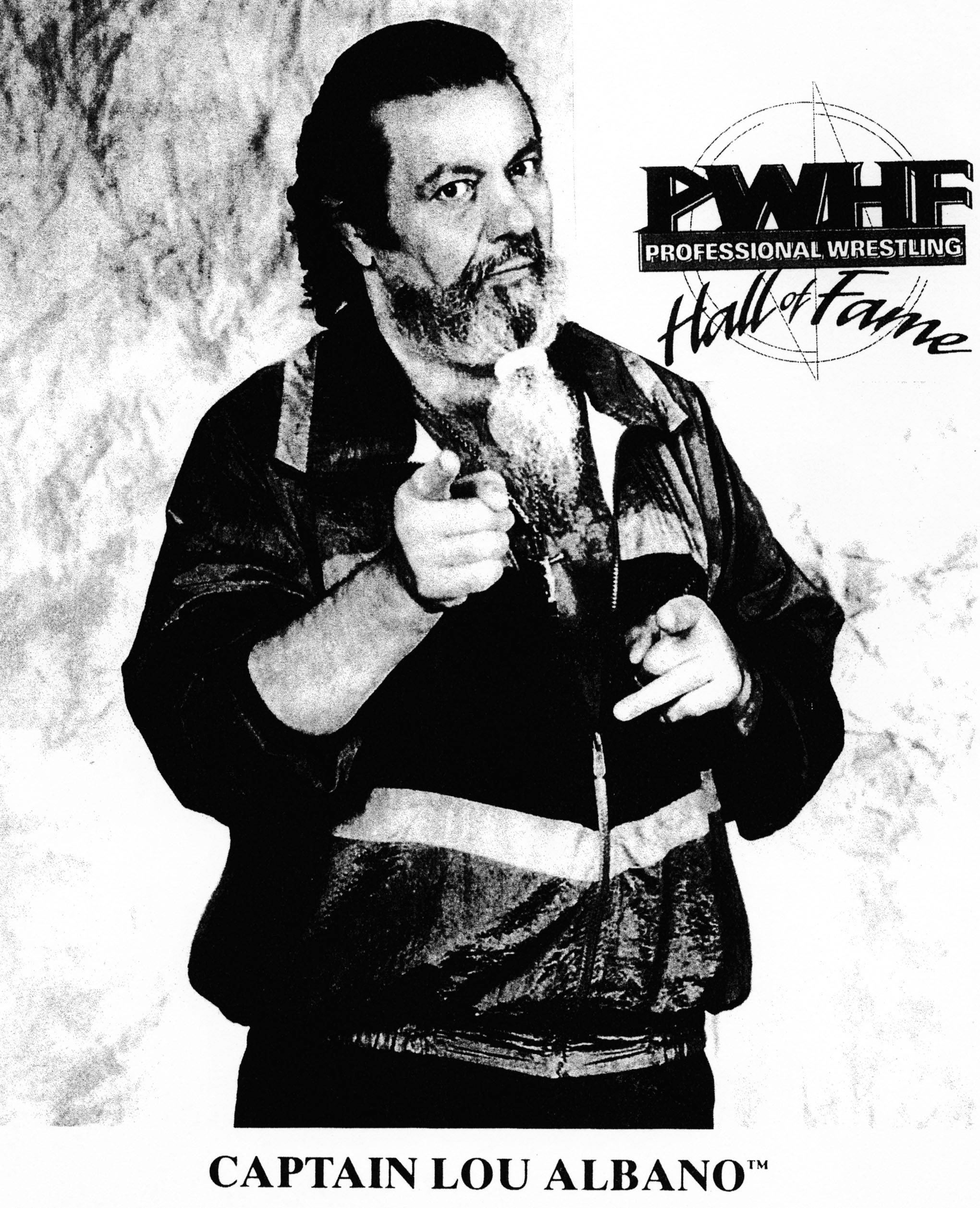
Albano also managed and performed with the rock group NRBQ and became a recurring star on the John Davidson-hosted version of Hollywood Squares.
It didn’t end there, because in 1989, Albano made an appearance on Live with Regis and Kathy Lee, where he shaved his beard on the air, for the purpose of playing the beloved video game character Mario in The Super Mario Brothers Super Show! He would not only perform live action sequences with his scene partner Danny Wells, but also provide voiceovers for the cartoon character.
In 1993, Albano appeared in the John Ritter film Stay Tuned, playing a ring announcer for a wrestling match.
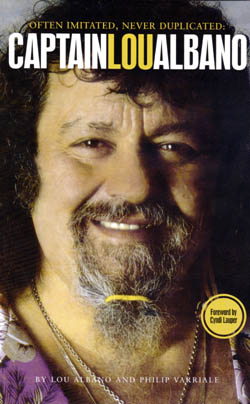
Albano was inducted into the WWE Hall of Fame in 1996 and, in 1998, he co-authored a book with Bert Sugar, called The Complete Idiot’s Guide to Pro Wrestling. His self-published autobiography, Captain Lou Albano: Often Imitated and Never Duplicated, came out in 2008. In 2009. he was inducted into the Professional Wrestling Hall of Fame, based in Amsterdam, NY, in the Non-Wrestler Category.
In the 1990s, Albano’s life started taking a turn for the worse. His health started becoming a major concern and he ended up losing 150 pounds in the decade, because of it. Albano suffered a heart attack in 2005, but, always a fighter, he was able to recover.
Unfortunately, his health problems finally caught up with him in recent years and he was in hospice care for a while, before his passing this morning at 3:30 a.m.
Albano is survived by his wife Gerry.
A private wake will be held at Balsamo-Cordovano Funeral Home in Carmel, NY from 2 p.m. to 4 p.m. and 7 p.m. to 9 p.m. Friday. A funeral Mass will take place at 11 a.m. Saturday at St. James the Apostle Church in Carmel.
RELATED LINKS
- Review: Albano book surprisingly coherent and factual
- Albano’s first book reviewed: Idiot’s Guide pretty good
- The Super Mario Bros. Super Show (TV) (1989)
